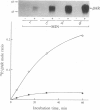Abstract
Agonist-promoted desensitization of adenylate cyclase is intimately associated with phosphorylation of the beta-adrenergic receptor in mammalian, avian, and amphibian cells. However, the nature of the protein kinase(s) involved in receptor phosphorylation remains largely unknown. We report here the identification and partial purification of a protein kinase capable of phosphorylating the agonist-occupied form of the purified beta-adrenergic receptor. The enzyme is prepared from a supernatant fraction from high-speed centrifugation of lysed kin- cells, a mutant of S49 lymphoma cells that lacks a functional cAMP-dependent protein kinase. The beta-agonist isoproterenol induces a 5- to 10-fold increase in receptor phosphorylation by this kinase, which is blocked by the antagonist alprenolol. Fractionation of the kin- supernatant on molecular-sieve HPLC and DEAE-Sephacel results in a 50- to 100-fold purified beta-adrenergic receptor kinase preparation that is largely devoid of other protein kinase activities. The kinase activity is insensitive to cAMP, cGMP, cAMP-dependent kinase inhibitor, Ca2+-calmodulin, Ca2+-phospholipid, and phorbol esters and does not phosphorylate general kinase substrates such as casein and histones. Phosphate appears to be incorporated solely into serine residues. The existence of this novel cAMP-independent kinase, which preferentially phosphorylates the agonist-occupied form of the beta-adrenergic receptor, suggests a mechanism that may explain the homologous or agonist-specific form of adenylate cyclase desensitization. It also suggests a general mechanism for regulation of receptor function in which only the agonist-occupied or "active" form of the receptor is a substrate for enzymes inducing covalent modification.
Full text
PDF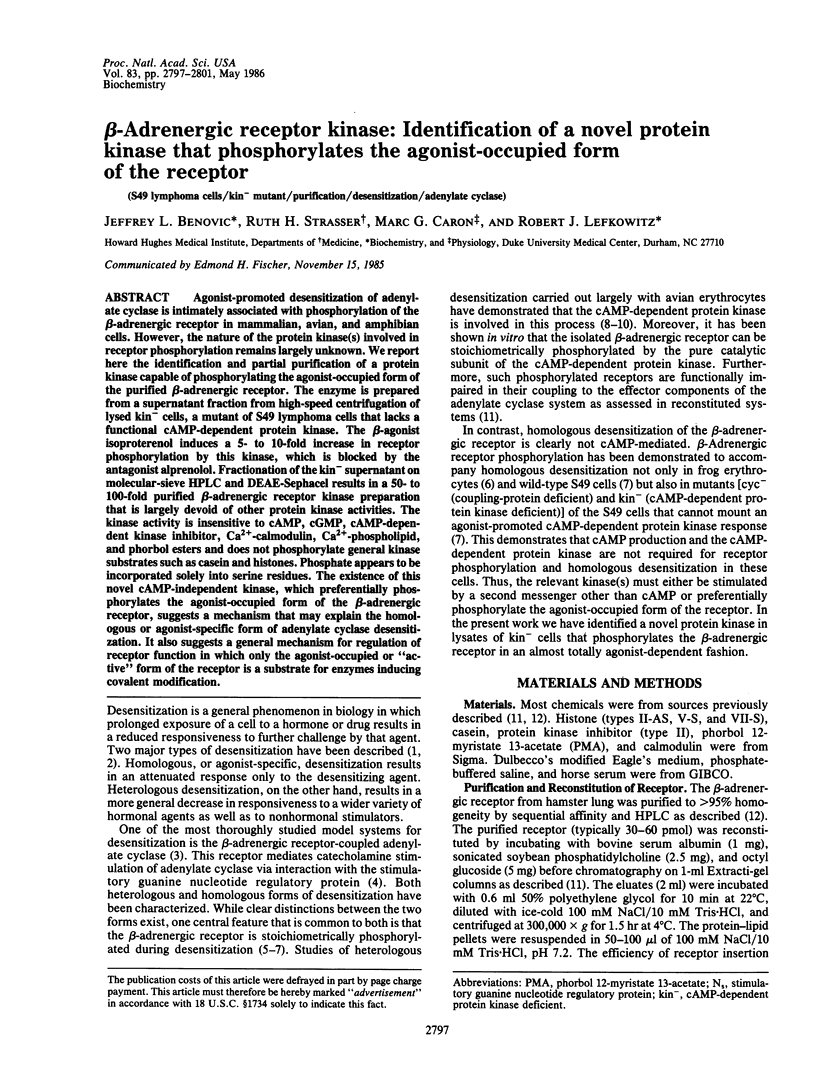
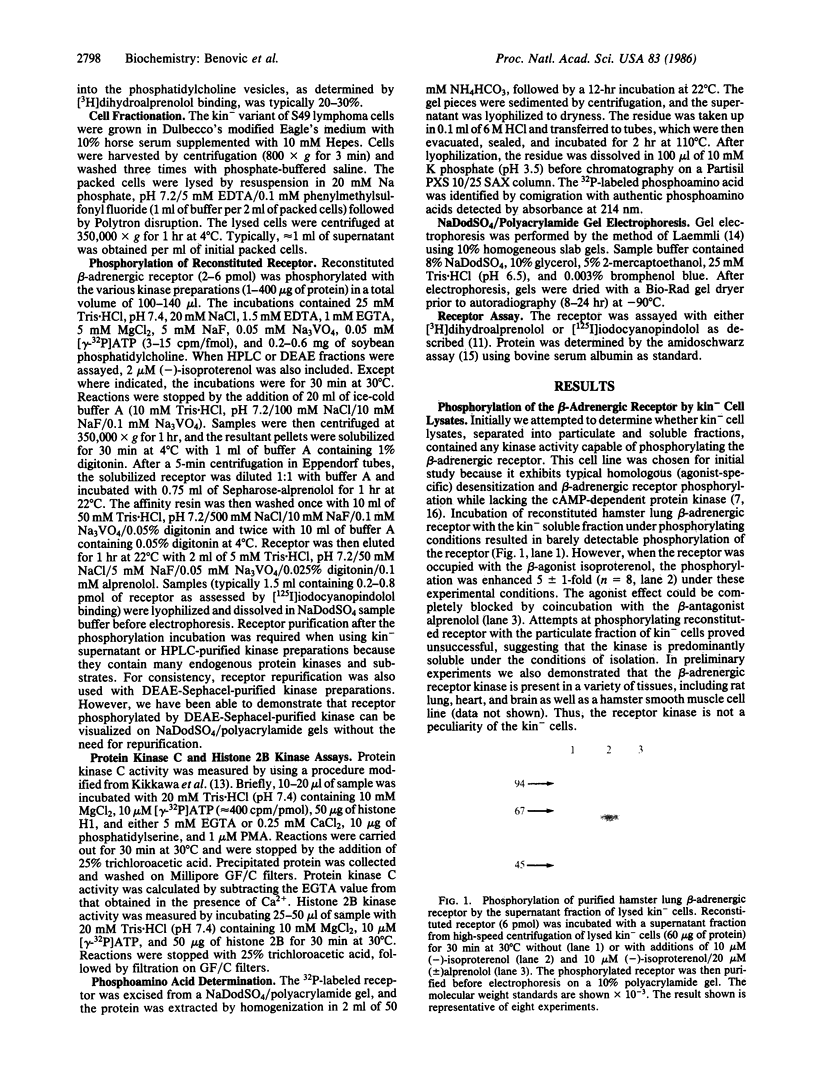
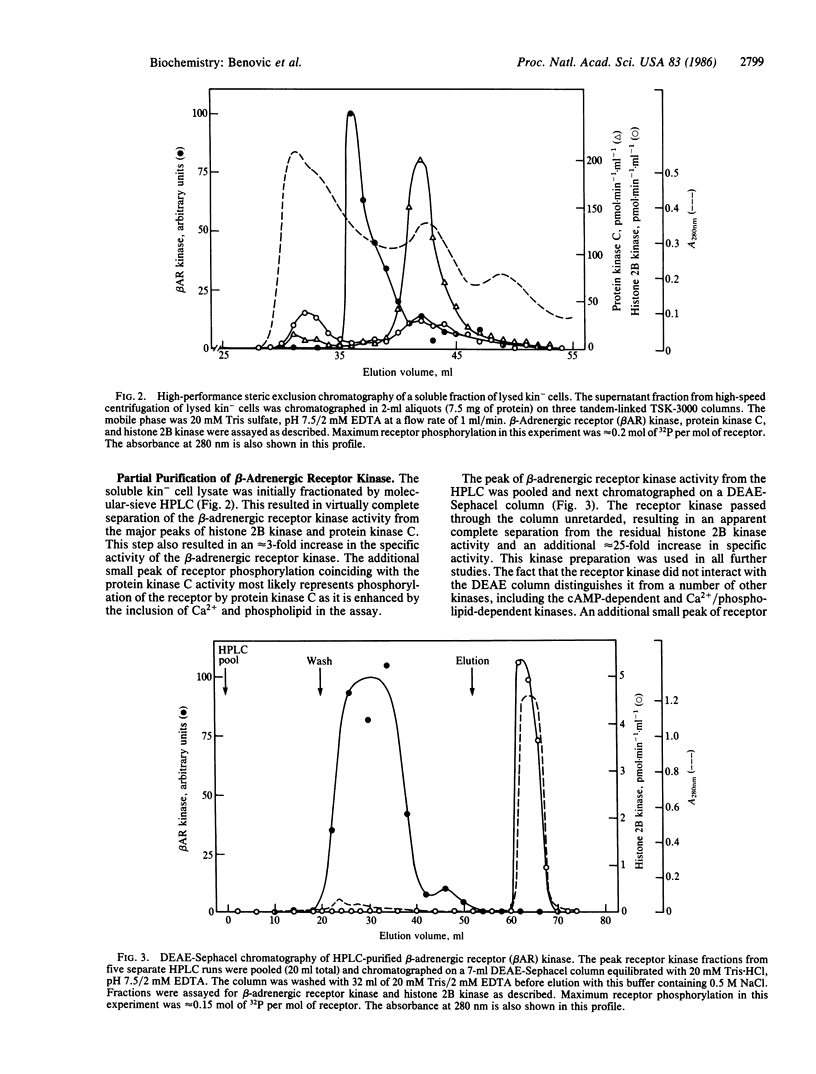
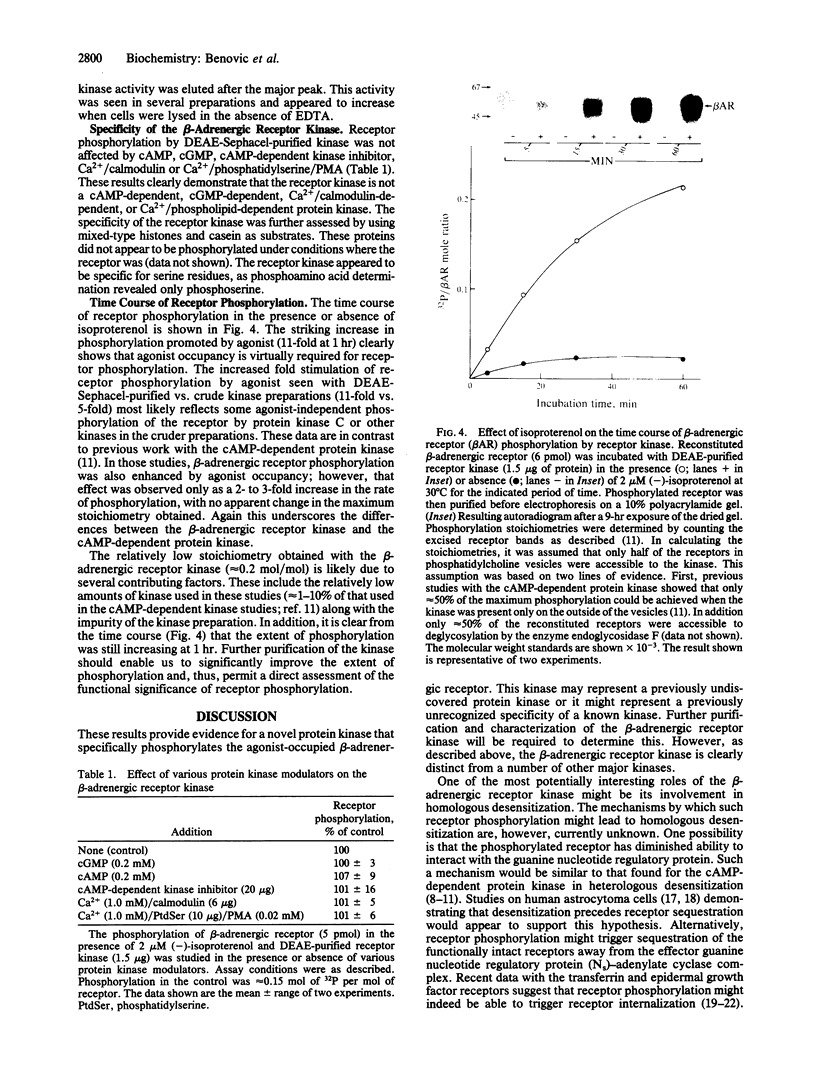
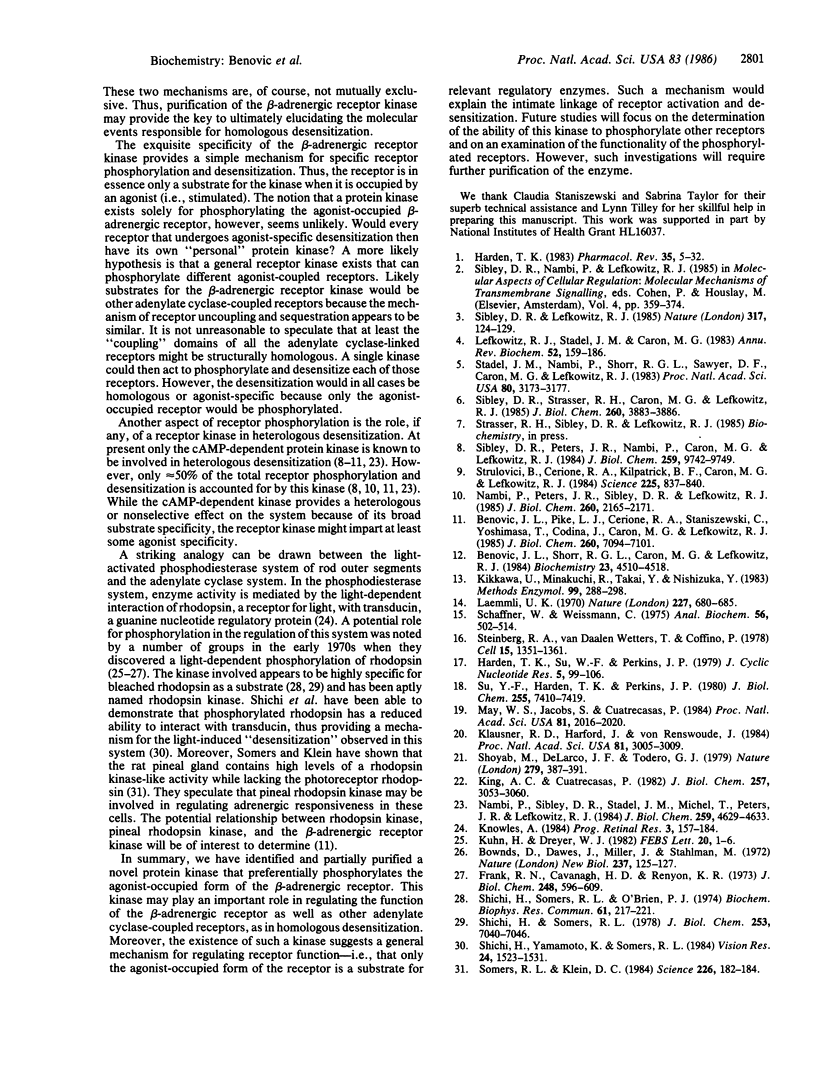
Images in this article
Selected References
These references are in PubMed. This may not be the complete list of references from this article.
- Benovic J. L., Pike L. J., Cerione R. A., Staniszewski C., Yoshimasa T., Codina J., Caron M. G., Lefkowitz R. J. Phosphorylation of the mammalian beta-adrenergic receptor by cyclic AMP-dependent protein kinase. Regulation of the rate of receptor phosphorylation and dephosphorylation by agonist occupancy and effects on coupling of the receptor to the stimulatory guanine nucleotide regulatory protein. J Biol Chem. 1985 Jun 10;260(11):7094–7101. [PubMed] [Google Scholar]
- Benovic J. L., Shorr R. G., Caron M. G., Lefkowitz R. J. The mammalian beta 2-adrenergic receptor: purification and characterization. Biochemistry. 1984 Sep 25;23(20):4510–4518. doi: 10.1021/bi00315a002. [DOI] [PubMed] [Google Scholar]
- Bownds D., Dawes J., Miller J., Stahlman M. Phosphorylation of frog photoreceptor membranes induced by light. Nat New Biol. 1972 May 24;237(73):125–127. doi: 10.1038/newbio237125a0. [DOI] [PubMed] [Google Scholar]
- Frank R. N., Cavanagh H. D., Kenyon K. R. Light-stimulated phosphorylation of bovine visual pigments by adenosine triphosphate. J Biol Chem. 1973 Jan 25;248(2):596–609. [PubMed] [Google Scholar]
- Harden T. K. Agonist-induced desensitization of the beta-adrenergic receptor-linked adenylate cyclase. Pharmacol Rev. 1983 Mar;35(1):5–32. [PubMed] [Google Scholar]
- Harden T. K., Su Y. F., Perkins J. P. Catecholamine-induced desensitization involves an uncoupling of beta-adrenergic receptors and adenylate cyclase. J Cyclic Nucleotide Res. 1979;5(2):99–106. [PubMed] [Google Scholar]
- Kikkawa U., Minakuchi R., Takai Y., Nishizuka Y. Calcium-activated, phospholipid-dependent protein kinase (protein kinase C) from rat brain. Methods Enzymol. 1983;99:288–298. doi: 10.1016/0076-6879(83)99064-x. [DOI] [PubMed] [Google Scholar]
- King A. C., Cuatrecasas P. Resolution of high and low affinity epidermal growth factor receptors. Inhibition of high affinity component by low temperature, cycloheximide, and phorbol esters. J Biol Chem. 1982 Mar 25;257(6):3053–3060. [PubMed] [Google Scholar]
- Klausner R. D., Harford J., van Renswoude J. Rapid internalization of the transferrin receptor in K562 cells is triggered by ligand binding or treatment with a phorbol ester. Proc Natl Acad Sci U S A. 1984 May;81(10):3005–3009. doi: 10.1073/pnas.81.10.3005. [DOI] [PMC free article] [PubMed] [Google Scholar]
- Kühn H., Dreyer W. J. Light dependent phosphorylation of rhodopsin by ATP. FEBS Lett. 1972 Jan 15;20(1):1–6. doi: 10.1016/0014-5793(72)80002-4. [DOI] [PubMed] [Google Scholar]
- Laemmli U. K. Cleavage of structural proteins during the assembly of the head of bacteriophage T4. Nature. 1970 Aug 15;227(5259):680–685. doi: 10.1038/227680a0. [DOI] [PubMed] [Google Scholar]
- Lefkowitz R. J., Stadel J. M., Caron M. G. Adenylate cyclase-coupled beta-adrenergic receptors: structure and mechanisms of activation and desensitization. Annu Rev Biochem. 1983;52:159–186. doi: 10.1146/annurev.bi.52.070183.001111. [DOI] [PubMed] [Google Scholar]
- May W. S., Jacobs S., Cuatrecasas P. Association of phorbol ester-induced hyperphosphorylation and reversible regulation of transferrin membrane receptors in HL60 cells. Proc Natl Acad Sci U S A. 1984 Apr;81(7):2016–2020. doi: 10.1073/pnas.81.7.2016. [DOI] [PMC free article] [PubMed] [Google Scholar]
- Nambi P., Peters J. R., Sibley D. R., Lefkowitz R. J. Desensitization of the turkey erythrocyte beta-adrenergic receptor in a cell-free system. Evidence that multiple protein kinases can phosphorylate and desensitize the receptor. J Biol Chem. 1985 Feb 25;260(4):2165–2171. [PubMed] [Google Scholar]
- Nambi P., Sibley D. R., Stadel J. M., Michel T., Peters J. R., Lefkowitz R. J. Cell-free desensitization of catecholamine-sensitive adenylate cyclase. Agonist- and cAMP-promoted alterations in turkey erythrocyte beta-adrenergic receptors. J Biol Chem. 1984 Apr 10;259(7):4629–4633. [PubMed] [Google Scholar]
- Schaffner W., Weissmann C. A rapid, sensitive, and specific method for the determination of protein in dilute solution. Anal Biochem. 1973 Dec;56(2):502–514. doi: 10.1016/0003-2697(73)90217-0. [DOI] [PubMed] [Google Scholar]
- Shichi H., Somers R. L. Light-dependent phosphorylation of rhodopsin. Purification and properties of rhodopsin kinase. J Biol Chem. 1978 Oct 10;253(19):7040–7046. [PubMed] [Google Scholar]
- Shichi H., Somers R. L., O'Brien P. J. Phosphorylation of rhodopsin: most rhodopsin molecules are not phosphorylated. Biochem Biophys Res Commun. 1974 Nov 6;61(1):217–221. doi: 10.1016/0006-291x(74)90555-5. [DOI] [PubMed] [Google Scholar]
- Shichi H., Yamamoto K., Somers R. L. GTP binding protein: properties and lack of activation by phosphorylated rhodopsin. Vision Res. 1984;24(11):1523–1531. doi: 10.1016/s0042-6989(84)80001-2. [DOI] [PubMed] [Google Scholar]
- Shoyab M., De Larco J. E., Todaro G. J. Biologically active phorbol esters specifically alter affinity of epidermal growth factor membrane receptors. Nature. 1979 May 31;279(5712):387–391. doi: 10.1038/279387a0. [DOI] [PubMed] [Google Scholar]
- Sibley D. R., Lefkowitz R. J. Molecular mechanisms of receptor desensitization using the beta-adrenergic receptor-coupled adenylate cyclase system as a model. Nature. 1985 Sep 12;317(6033):124–129. doi: 10.1038/317124a0. [DOI] [PubMed] [Google Scholar]
- Sibley D. R., Peters J. R., Nambi P., Caron M. G., Lefkowitz R. J. Desensitization of turkey erythrocyte adenylate cyclase. Beta-adrenergic receptor phosphorylation is correlated with attenuation of adenylate cyclase activity. J Biol Chem. 1984 Aug 10;259(15):9742–9749. [PubMed] [Google Scholar]
- Sibley D. R., Strasser R. H., Caron M. G., Lefkowitz R. J. Homologous desensitization of adenylate cyclase is associated with phosphorylation of the beta-adrenergic receptor. J Biol Chem. 1985 Apr 10;260(7):3883–3886. [PubMed] [Google Scholar]
- Somers R. L., Klein D. C. Rhodopsin kinase activity in the mammalian pineal gland and other tissues. Science. 1984 Oct 12;226(4671):182–184. doi: 10.1126/science.6091271. [DOI] [PubMed] [Google Scholar]
- Stadel J. M., Nambi P., Shorr R. G., Sawyer D. F., Caron M. G., Lefkowitz R. J. Catecholamine-induced desensitization of turkey erythrocyte adenylate cyclase is associated with phosphorylation of the beta-adrenergic receptor. Proc Natl Acad Sci U S A. 1983 Jun;80(11):3173–3177. doi: 10.1073/pnas.80.11.3173. [DOI] [PMC free article] [PubMed] [Google Scholar]
- Steinberg R. A., van Daalen Wetters T., Coffino P. Kinase-negative mutants of S49 mouse lymphoma cells carry a trans-dominant mutation affecting expression of cAMP-dependent protein kinase. Cell. 1978 Dec;15(4):1351–1361. doi: 10.1016/0092-8674(78)90060-0. [DOI] [PubMed] [Google Scholar]
- Strulovici B., Cerione R. A., Kilpatrick B. F., Caron M. G., Lefkowitz R. J. Direct demonstration of impaired functionality of a purified desensitized beta-adrenergic receptor in a reconstituted system. Science. 1984 Aug 24;225(4664):837–840. doi: 10.1126/science.6089331. [DOI] [PubMed] [Google Scholar]
- Su Y. F., Harden T. K., Perkins J. P. Catecholamine-specific desensitization of adenylate cyclase. Evidence for a multistep process. J Biol Chem. 1980 Aug 10;255(15):7410–7419. [PubMed] [Google Scholar]




